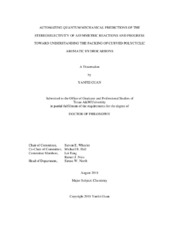| dc.description.abstract | Modern computational chemistry has emerged as a powerful tool for understanding functional molecules including catalysts, materials, and pharmaceuticals. Such theoretical studies can inform the rational design of new structures such as effective catalysts and high performed organic semiconductors. In this dissertation, applications of computational chemistry to the fields of asymmetric catalysis and organic electronic materials based on polycyclic aromatic hydrocarbons are presented.
The first part of this dissertation focuses on the development and application of computational tools for the automated prediction of stereoselectivities for asymmetric catalytic reactions. Despite the enormous success of quantum chemistry in explaining the activity and selectivity of a wide range of catalytic reactions, the computational design of new catalysts is far from routine due to the vast number of computations that must be performed for a given system. A computational toolkit has been developed (AARON: An Automated Reaction Optimizer for New-catalysts) to automatically screen virtual libraries of potential catalyst designs quantum mechanically. First, an explanation of the AARON workflow is provided along with several representative applications demonstrating the utility of AARON in the context of catalysts design. Then, a more detailed example of the application of AARON to a Rh-catalyzed asymmetric hydrogenation reaction is presented in which AARON is used to screen a series of ligands and design a novel chiral.
In the second part, the primary goal is to understand the underlying noncovalent interactions responsible for the supramolecular assembly of curved molecules and thus to precisely control supramolecular architectures. First, a study of four bowl-shaped polycyclic aromatic hydrocarbon molecules (summanene and derivatives) is presented that combines quantum mechanical methods and molecular dynamics simulations to understand the local orientations within columnar stacks, which significantly impacts the electronic properties of the resulting semiconducting materials. The importance of intercolumnar interactions on intracolumnar packing is also highlighted. Next, we consider contorted polycyclic aromatic molecules. These doubly-concave systems offer a means of tuning the strength of stacking interactions through variations in molecular curvature. A systematically study of a set of 18 saddle-shaped compounds and their dimers indicates that the introduction of thiophene rings around the periphery of these systems and the incorporation of B and N atoms into the coronene core greatly enhances their tendency to form strongly stacked dimers. Ultimately, a complex relationship between curvature of molecules and stacking interaction is revealed.
Together, the chapters in this thesis showcase the power of modern computational quantum chemistry to provide useful predictions of the structure and properties of molecules. | en |


